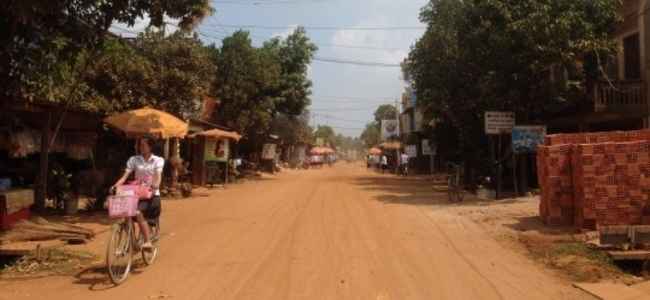A year on since the start of the pandemic, the work to rebuild Cambodia has begun and the private sector will have to play a key role in bridging what could otherwise become a widening rural-urban poverty gap.
In 2019, nearly a tenth of Cambodians were below the poverty line defined as those earning less than two dollars a day. Of those mired in poverty, nearly 90% live in rural areas. Cambodia, which is rapidly urbanizing, is still a largely rural country with nearly three-fourths of the population living in the countryside.
Since the pandemic, the number of poor Cambodians, most of whom will be rural residents and returning migrants, will double as families get further embroiled in debt, struggle to meet basic needs such as food, water and healthcare and children drop out from schools. It will mean that even if the situation appears to be improving in cities, we must not forget that it will take longer to get back to the pre-pandemic state scenario in rural areas.
It’s all quite a shame as Cambodia was doing so well before the pandemic having achieved what the World Bank specifies as lower-middle income status. Earlier, Prime Minister Hun Sen had even declared on a visit to China an ambition to help Cambodia attain upper-middle income status by 2030 joining the likes of Malaysia, Thailand and Sri Lanka. (The latter, however, fell back into middle income status due to the pandemic.) It would have meant well-connected roads, quality higher education and gainful employment in rural areas.
Instead, there’s a danger that rural residents will now have unequal access to education, relief facilities and healthcare. The rapid shuttering of garment factories and other businesses has decimated livelihoods and makes it more difficult for consumers to feel confident enough to spend on goods and services.
While it’s true that the Cambodian government has spent a considerable amount of money to ensure the most vulnerable get some form of assistance – the government has spent $1.4 billion so far, double the amount it anticipated – it can only do so much. Getting employers to hire once more and invest in the future will be key.
The private sector’s role
Around the world, private sector spending has fallen across developing countries. In Cambodia, there were 279 projects in various stages of construction in Phnom Penh at the end of last year. At the same time in the previous year, there were more than 400 projects.
The malaise in the construction sector is just symptomatic of the broader slowdown in private sector activity. Mostly situated in urban areas, large private companies play a key role as the engine for economic growth in developing countries.
The good news is that urban areas like Phnom Penh and Sihanoukville have mostly been vaccinated – more than 95 percent of a target population of 10 million adults have been reached across the country. Business leaders can safely make plans without being worried about disruptions to economic activity.
They need to be bold and continue projects or kick start new activity even if consumers and buyers don’t appear to be ready. If they prepare well, they can make a mark on stakeholders. Top companies around the world have signaled messages of hope and optimism that have emboldened and heartened consumers who have then rewarded them with their patronage at better times.
If the private sector kicks back into gear, there will also be a virtuous cycle that can ultimately help rural residents in the end. In developing countries, governments do not have as much funds as their developed world peers. As their worsening deficits, largely due to anti-pandemic initiatives, threaten to hamper their ability to borrow funds from capital markets, private sector-led investment and business activity can lead to the creation of jobs and rise in incomes that will ultimately supplement tax revenue. Such funds are essential for the construction of public goods like bridges, laptops for schools and a telecom infrastructure so that rural residents living in remote areas can secure services like primary healthcare, education and other basic services.
In rural areas, there’s already an infrastructure gap that governments, multilateral institutions, and development organizations know they need to work on. In particular, the pandemic showed the unequal access to digital infrastructure (access to internet and computers etc.) with children living in rural areas often unable to attend online classes because of lack of access to the internet.
In particular, the biggest private enterprises with a multi-sector presence can do a lot to show the way forward. With their deep pools of reserves and substantial cash flows from a diversified revenue base, they can invest in new and existing projects even if they don’t lead to short-term profits and help restore business and consumer confidence. One way or another, their activities will have an impact on rural areas.
Some good examples
Many private companies in Cambodia have shown a willingness to do their part.
For example, Prince Holding Group, a fast-growing conglomerate, has done a lot this year for rural communities. Not only did Prince Holding Group Chairman Neak Oknha Chen Zhi donate $3 million to help Cambodia purchase 1 million COVID-19 vaccines, he has ensured the conglomerate established a partnership with Caring For Cambodia, a leading education charity, to help hundreds of Cambodian high school students prepare for university after a year of disruption.
Furthermore, Chen Zhi Cambodia and Prince Group has also announced the largest scholarship programme sponsored by a private company that promises to provide nearly $2 million in financial aid to 400 students over seven years.
Prince Holding Group is also the parent of Canopy Sands Development, a Sihanoukville-focused developer that announced plans to start work on Ream City, a residential and commercial development built on reclaimed land in Ream Bay built along sustainable development lines. The project promises to revitalize a changing Sihanoukville that is fast becoming an industrial and commercial cluster.
Similarly, Socfin Cambodia, a Belgian company active in the development and management of oil palm and rubber plantations, has built bridges, roads, hospitals, schools and provided jobs to local communities living in the Bousra region. Over the course of the pandemic, it donated school supplies and conducted training to help children understand the importance of hygiene and best practices to prevent the spread of Covid-19.
As a company, Socfin runs 330 schools globally and 6 tapping schools that teach adults in Africa and Southeast Asia how to enter the natural rubber industry.
Neak Oknha Dr Pung Keav Se, Chairman of Canadia Bank and Overseas Cambodian Investment Corporation (OCIC), is another noteworthy Cambodian individual who came to the aid of local communities. OCIC converted its properties in Diamond Island, including Canadia International School (CIS), into vaccination sites serving nearly 30,000 adults. Dr Keav Se also launched Cambodia University of Technology and Science (CamTech) in 2018 and has publicly stated that outstanding Cambodian students keen to study technical courses will get low-interest loans.
Meanwhile, OCIC is resuming efforts to build a satellite city in Koh Norea that aims to bring $2.5 billion in committed capital to the region.
Most poor Cambodians living in the countryside working in farms and tending animals might not immediately see the benefit of such activities. However, restoring private sector activity will go a long way towards improving their fortunes. Not only will it help restore demand for their services, the new jobs that are created offer a stable income and other benefits. Many estimates indicate that the pace of urbanization is set to continue with Phnom Penh expected to double in size – it will be essential that secure jobs are created that add value to the Cambodian economy instead of informal sector jobs that do not. The growth of the migrant economy will, in turn, enhance rural development through remittances.
In the end, the government and the private sector need to work diligently and embrace a partnership following a holistic long-term plan. If everything goes well, it is hoped that Cambodia will be able to bounce back more quickly than expected and rural families don’t get left behind in the march towards progress.




















